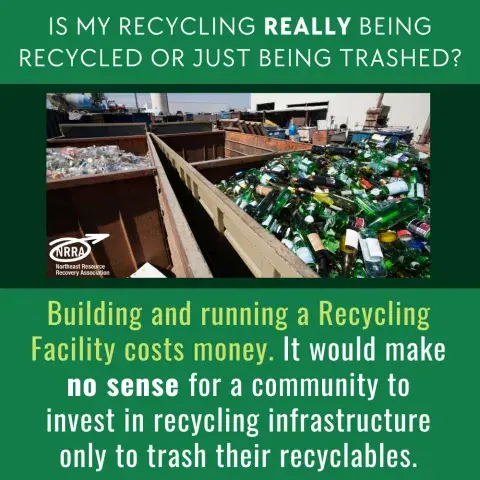
YOU ASKED: IS MY RECYCLING *REALLY* BEING RECYCLED OR JUST BEING TRASHED?
Great question! This is something we more often hear from communities with single-stream recycling, where all recyclables are put together into the same bin and hauled away to a magic recycling facility.
The short answer is YES, the vast majority of your recycling IS being recycled. There will of course be cases where recycling CONTAMINATION creeps in and ruins a small percentage of the recyclable material. (This is why we talk about contamination so much - when in doubt, throw it out!) But again, the majority of recyclables sent to a transfer station or recycling center ARE recycled.
From our experience, when looking only at NRRA member communities, the approximate contamination rate for source-separated communities is less than 5% and the approximate contamination rate for single-stream communities is between 10-30%.
That means that 70-95% of all recyclables are being processed into raw materials!
If you think about it strictly from a money-making perspective, it's easy to see why recycling the recyclables (versus landfilling or incinerating them) makes sense. It costs money to build, run, and maintain a transfer station or recycling center - from staffing to building and grounds to the machinery required - recycling centers need to make a revenue to support themselves, just like any other manufacturer. (And remember, recycling IS a manufacturing process!) Communities want to be sure as much is being recycled as possible so they can avoid landfilling or incineration costs.
FURTHER INFORMATION:
Here is a story map of how glass is recycled in NH: https://www.nrrarecycles.org/glass-recycling-story-map
Casella put together a great video on what happens to single-stream recycling: https://youtu.be/NOHlPfI3c90
This material is based upon work supported under a grant by the Rural Utilities Service, United States Department of Agriculture. Any opinions, findings, and conclusions or recommendations expressed in this material are solely the responsibility of the authors and do not necessarily represent the official views of the Rural Utilities Service. Rural Community Assistance Partnership, Inc., is an equal opportunity provider and employer.
